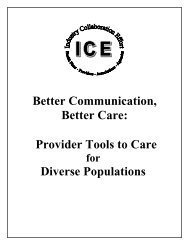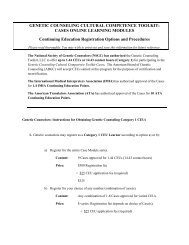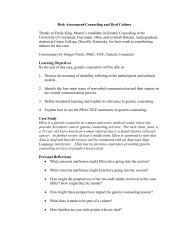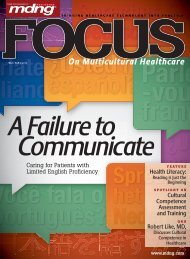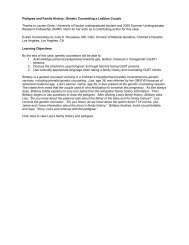Advanced Effective Communication, Cultural Competence, and ...
Advanced Effective Communication, Cultural Competence, and ...
Advanced Effective Communication, Cultural Competence, and ...
Create successful ePaper yourself
Turn your PDF publications into a flip-book with our unique Google optimized e-Paper software.
A Roadmap for Hospitals<br />
Chapter Six: Organization Readiness<br />
• Consider varying the methods used to provide staff<br />
training, including in-service sessions, gr<strong>and</strong> rounds,<br />
case studies, DVD courses, <strong>and</strong> online modules.*<br />
• Provide staff training opportunities at intervals<br />
throughout the year (for example, new staff<br />
orientation, ongoing training).<br />
• Incorporate staff training into yearly performance<br />
expectations.<br />
• Support the hospital’s current efforts to address<br />
effective communication, cultural competence, <strong>and</strong><br />
patient- <strong>and</strong> family-centered care. For example, train<br />
staff to address patient communication needs,<br />
including patients whose preferred language is not<br />
English or patients who have sensory or<br />
communication impairments.<br />
• Encourage staff to improve their overall<br />
communication skills, including communication<br />
between patients <strong>and</strong> providers <strong>and</strong> communication<br />
between providers.<br />
• Address unique patient needs in relevant policies <strong>and</strong><br />
procedures (for example, visitation, access to chosen<br />
support person, nondiscrimination).<br />
• Inform staff about federal <strong>and</strong> state laws <strong>and</strong> regulations<br />
that support effective communication, cultural<br />
competence, <strong>and</strong> patient- <strong>and</strong> family-centered care. †<br />
❑ Identify staff concerns or suggested<br />
improvements for providing care that<br />
meets unique patient needs.<br />
The hospital relies on its staff to communicate effectively<br />
<strong>and</strong> provide culturally competent, patient- <strong>and</strong> familycentered<br />
care. Staff should have the opportunity to voice<br />
any concerns with or suggest improvements to meet unique<br />
patient cultural, religious, spiritual, mobility, or other needs.<br />
• Conduct a staff survey to evaluate the staff’s current<br />
ability to meet patient needs, including their experiences<br />
using language services <strong>and</strong> auxiliary aids, barriers to<br />
accommodating cultural <strong>and</strong> religious or spiritual needs,<br />
<strong>and</strong> any other issues that should be addressed.<br />
• Create an environment that welcomes diverse staff<br />
members which, in turn, welcomes diverse patients.<br />
Provide support for staff caucuses or special interest<br />
groups to freely <strong>and</strong> openly discuss any cultural,<br />
religious, disability, LGBT, or other concerns.<br />
• Promote staff discussion around the challenges <strong>and</strong><br />
barriers to providing care that meets unique patient<br />
needs. For example, consider implementing Schwartz<br />
Center Rounds , which provides multidisciplinary<br />
providers an opportunity to discuss difficult emotional<br />
<strong>and</strong> social issues that arise while caring for patients [19].<br />
• Protect staff from discrimination based on age, race,<br />
ethnicity, religion, culture, language, physical or<br />
mental disability, socioeconomic status, sex, sexual<br />
orientation, or gender identity or expression.<br />
Recommended Issues <strong>and</strong><br />
Related Practice Examples that<br />
Address the Provision of Care,<br />
Treatment, <strong>and</strong> Services Domain<br />
of Organization Readiness<br />
❑ Create an environment that is inclusive<br />
of all patients.<br />
It is important for the physical hospital environment to<br />
support the diversity of the patient population. From the<br />
layout of the waiting areas to accessible equipment to the<br />
navigational signage to artwork <strong>and</strong> magazine selection,<br />
hospitals can create a welcoming atmosphere to put<br />
patients at ease.<br />
• Incorporate the concepts <strong>and</strong> principles of universal<br />
design to create a physical environment inclusive of all<br />
patients. The hospital can use the universal design<br />
philosophy when building or remodeling hospital<br />
spaces or purchasing medical equipment to make sure<br />
facilities, products, <strong>and</strong> services can be used <strong>and</strong><br />
accessed by all people. Table 6-4 , on page 40, outlines<br />
the seven principles of universal design [20].<br />
• Provide a diverse collection of magazines <strong>and</strong> brochures<br />
in the waiting area inclusive of the preferences of all<br />
patients. The hospital should consider from among the<br />
many publications tailored to different populations,<br />
cultures, <strong>and</strong> communities when selecting materials to<br />
match their patient population.<br />
• Reflect the diversity of the patient population in hospital<br />
marketing materials <strong>and</strong> decor.<br />
• Make sure navigational signage can be understood by<br />
the patient population. Incorporate pictures or symbols<br />
into navigational signage, or consider providing<br />
bilingual signage.<br />
* See Appendix E: Resource Guide (pages 80 <strong>and</strong> 81) for further information on staff training resources <strong>and</strong> courses.<br />
† See Appendix D: Laws <strong>and</strong> Regulations (page 65) for additional information on laws <strong>and</strong> regulations.<br />
39



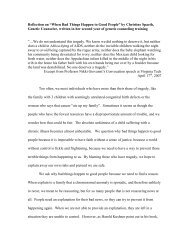
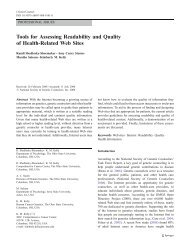

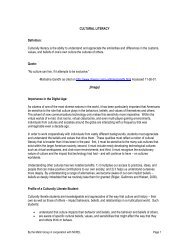
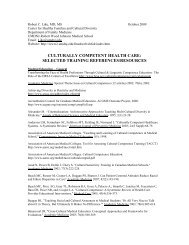

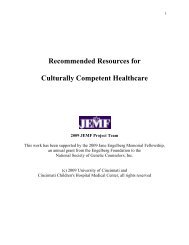

![Breaking Bad News PPT[1] - Genetic Counseling Cultural ...](https://img.yumpu.com/35003134/1/190x146/breaking-bad-news-ppt1-genetic-counseling-cultural-.jpg?quality=85)
